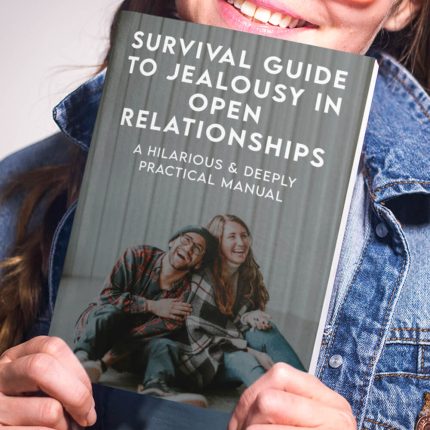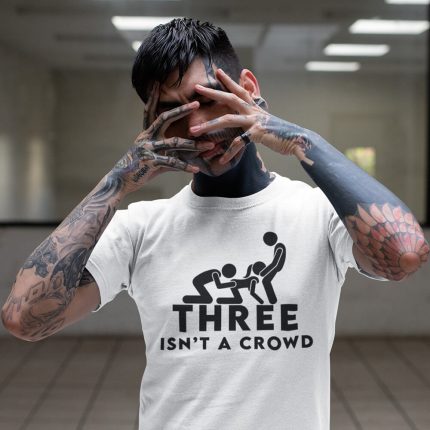Guide to Poly V Type Dynamic

Welcome, open-minded explorers and relationship renegades! If you’ve ever found yourself intrigued by the idea of a “Poly V Type Dynamic” – a relationship structure where one central partner connects with two or more partners who may not be connected to each other – then you’ve come to the right place. This comprehensive guide delves deep into the poly V type dynamic, exploring its definitions, core principles, benefits, challenges, and practical strategies to help you navigate and thrive in this unique relationship model. Whether you’re new to polyamory or a seasoned practitioner looking for fresh insights, this guide is designed to empower you with the knowledge and tools to create and maintain a balanced, fulfilling poly V relationship.
Have you ever wondered if monogamy is just a stupid little experiment? Open relationships, polyamory, relationship anarchy...find out which relationship dynamic suits you best with our one minute relationship test. See if you are just conforming to "societal norms". Reveal your truth >>
Quick Links to Useful Sections
- Understanding the Poly V Type Dynamic
- Defining the Poly V Type
- Historical Context and Evolution
- The Roots of the V Dynamic
- Core Principles of the Poly V Type Dynamic
- 1. Open Communication and Transparency
- 2. consent and Mutual Respect
- 3. Flexibility and Adaptability
- 4. Emotional Awareness and Self-Reflection
- Benefits of a Poly V Type Dynamic
- Deep Emotional Fulfillment
- Enhanced Communication and Conflict Resolution
- Flexibility in Relationship Structure
- Opportunities for Personal Growth
- Challenges of the Poly V Dynamic and How to Overcome Them
- Managing Jealousy and Insecurity
- Balancing Time and Emotional Energy
- Negotiating Shifting Boundaries
- Dealing with External Stigma and Misunderstanding
- Practical Tips for Thriving in a Poly V Dynamic
- 1. Establish Clear Communication Protocols
- 2. Set and Revisit Boundaries Regularly
- 3. Utilize Digital Tools for Organization
- 4. Engage in Self-Reflection and Personal Growth
- 5. Build a Support Network
- 6. Prioritize Self-Care
- Real-Life Stories: Voices from the Poly V Community
- Case Study: Jamie’s Balancing Act
- Case Study: Taylor’s Journey of Adaptation
- Expert Insights on Poly V Dynamics
- FAQ: Your Poly V Dynamic Questions Answered
Understanding the Poly V Type Dynamic
Defining the Poly V Type
The term “Poly V Type” refers to a specific configuration in polyamorous relationships characterized by a “V” shape. In this dynamic, one individual – often considered the central or primary partner – is connected to two or more other partners who typically do not have romantic or sexual relationships with each other. This structure is distinct from a triad (where all members interact with one another) or a hierarchical polyamorous arrangement (which may designate a primary partner with secondary partners). Instead, the V dynamic focuses on a central figure whose relationships with the other partners are independent of one another.
For example, imagine a “V” where the point represents the central partner, and the two arms represent two other partners who have their own unique connections with the central partner but no direct relationship with each other. This arrangement can extend beyond two partners, forming a multi-branch network that still centers around one individual’s primary connections.
It’s important to note that the poly V type dynamic is not inherently hierarchical or rigid. While one partner might naturally take on a more central role, the nature and depth of each connection can vary based on personal needs, mutual agreements, and the organic evolution of feelings over time.
Historical Context and Evolution
The Roots of the V Dynamic
Although the term “poly V” is relatively modern, the concept of one person being connected to multiple partners without requiring those partners to interact is not new. Historically, various cultures have practiced forms of non-monogamous relationships that bear resemblance to the V dynamic. Over time, as polyamory emerged as a consciously chosen lifestyle, individuals began to label and refine different relationship configurations. The poly V type dynamic emerged as one way to describe a structure that values a central, emotionally fulfilling connection while allowing the freedom to explore additional relationships on one’s own terms.
This evolution is closely linked to the broader polyamorous movement, which emphasizes open communication, self-determination, and the rejection of traditional relationship constraints. In modern polyamory, the V dynamic is celebrated for its flexibility and its potential to meet diverse emotional needs without forcing a one-size-fits-all model.
Core Principles of the Poly V Type Dynamic
1. Open Communication and Transparency
Communication is the cornerstone of any healthy relationship, and it’s especially critical in a poly V dynamic. With multiple relationships in play, ensuring that everyone’s on the same page is vital. Open communication involves regular check-ins, honest sharing of feelings, and an ongoing dialogue about needs, expectations, and boundaries. In a V dynamic, the central partner and the peripheral partners must be transparent about their feelings and any changes in their emotional landscape.
Techniques such as “I” statements, active listening, and scheduled communication sessions can help maintain clarity and prevent misunderstandings. Transparency builds trust, which is essential for managing the inherent complexities of a multi-partner arrangement.
EXPLORE OUR ETHICAL NON-MONOGAMY & OPEN RELATIONSHIP SHOP
👨💻👩💻 Digital Store (Instant Download)
🍆💦 Clothing Store (Worldwide Delivery Available)
Fuck Each Other Not The Planet Unisex T-Shirt (Black)
$29.99Multiple Lovers - Sharing Is Caring Unisex T-Shirt (Black)
$29.99Real Men Share Pop Art T-Shirt (Black)
$29.99Sharing Is Caring Daddy Cap (Black)
$39.99Three Isn't a Crowd Unisex T-Shirt (Black)
$29.99Three Isn't a Crowd Unisex T-Shirt (White)
$29.99I Love Watching Pop Art T-Shirt (Black)
$29.99I Love Watching Pop Art T-Shirt (White)
$29.99Fuck Each Other Not The Planet Unisex T-Shirt (White)
$29.99Sharing Is Caring Unisex T-Shirt (Black)
$29.99It's Not Cheating If He Watches T-Shirt (Black)
$29.99Real Men Share Pop Art T-Shirt (White)
$29.992. consent and Mutual Respect
At the heart of ethical polyamory lies the principle of free and informed consent. In a poly V dynamic, all parties must agree to the arrangement without coercion. Each partner’s boundaries and desires should be respected and honored. Mutual respect ensures that even if one partner is more central than the others, no relationship is devalued or taken for granted.
Consent is not a one-time agreement; it is an ongoing process that requires regular reaffirmation. Clear agreements about what is acceptable – and what is not – help create a safe space for all individuals involved.
3. Flexibility and Adaptability
One of the defining characteristics of a poly V dynamic is its flexibility. Relationships are not static; they evolve as the needs, desires, and circumstances of those involved change. The V dynamic is adaptable, allowing partners to renegotiate boundaries, adjust expectations, and shift roles over time. This flexibility is particularly valuable in polyamorous relationships, where personal growth and change are inevitable.
Embracing flexibility means being open to revisiting agreements and understanding that a central connection today might shift in significance in the future. Adaptability helps maintain balance and ensures that the relationship structure continues to serve everyone’s best interests.
4. Emotional Awareness and Self-Reflection
Navigating a poly V dynamic requires a high degree of self-awareness. Each partner must be in tune with their own emotions and be willing to engage in regular self-reflection. This practice helps in identifying feelings of jealousy, insecurity, or neglect before they escalate into larger issues. Journaling, mindfulness exercises, and even periodic therapy sessions can be valuable tools in fostering emotional awareness.
By understanding your own emotional triggers and needs, you can communicate more effectively with your partners and contribute to a healthier, more supportive relationship network.
Benefits of a Poly V Type Dynamic
Deep Emotional Fulfillment
One of the greatest benefits of the poly V dynamic is the potential for deep emotional fulfillment. Having a central, emotionally significant connection can provide stability and security, serving as an anchor in the often fluid landscape of polyamory. This central bond can offer the intimacy and support that many individuals crave, even as they maintain additional relationships.
For peripheral partners, knowing that their connection is distinct and valued can lead to a sense of empowerment and individuality. The poly V structure allows for both shared and independent fulfillment, creating a rich tapestry of emotional support.
Enhanced Communication and Conflict Resolution
Because the poly V dynamic necessitates clear communication among all involved, many participants report that their overall communication skills improve significantly. Regular discussions about feelings, expectations, and boundaries help foster a culture of honesty and mutual support. In turn, this environment can lead to more effective conflict resolution, as issues are addressed promptly and respectfully.
Flexibility in Relationship Structure
The adaptability of the poly V dynamic is a significant advantage. Without rigid hierarchies, the relationships within a V configuration can evolve naturally. This flexibility allows you to tailor your connections to meet your changing needs, whether that means deepening a particular bond or redefining the roles of the peripheral partners.
Flexibility also means that if circumstances change – such as moving, shifting career priorities, or changes in personal growth – the structure of your relationships can adjust accordingly. This adaptability helps ensure long-term satisfaction and reduces the stress that can come from trying to fit into a fixed model.
Opportunities for Personal Growth
Engaging in a poly V dynamic can be a transformative experience. The process of managing multiple relationships and continuously renegotiating boundaries forces you to become more self-aware and resilient. Over time, you may find that your ability to handle complex emotions improves, and you develop a stronger sense of self.
Personal growth is not only beneficial for your individual well-being but also enhances the quality of your relationships. As you become more adept at understanding your needs and communicating them clearly, you contribute to a healthier and more supportive network of connections.
Challenges of the Poly V Dynamic and How to Overcome Them
Managing Jealousy and Insecurity
Even in the most well-structured poly V dynamic, feelings of jealousy and insecurity can arise. When one partner appears more central than the others, it may trigger fears of inadequacy or neglect among the peripheral partners. Addressing these emotions is critical. Strategies include open communication, self-reflection, and, if necessary, professional support through therapy.
Regularly discussing your feelings and reaffirming your commitments can help manage jealousy. Remember, it’s normal to experience these emotions, and acknowledging them is the first step toward resolution.
Balancing Time and Emotional Energy
One of the practical challenges in a poly V dynamic is balancing the time and emotional energy you invest in the central relationship versus the peripheral ones. It can be demanding to ensure that each connection receives the attention it deserves without overwhelming you. Effective time management, setting clear priorities, and using digital tools to schedule and coordinate time can help address this challenge.
Consider using shared calendars or scheduling apps to plan quality time with each partner, ensuring that no relationship is inadvertently neglected.
Negotiating Shifting Boundaries
The fluid nature of poly V relationships means that boundaries are not set in stone. As personal needs evolve, it’s important to regularly revisit and renegotiate these boundaries. This process can be challenging, as it may require difficult conversations and a willingness to adjust longstanding expectations.
Establish a routine of periodic check-ins to discuss what is working and what may need to change. Flexibility and mutual respect are key to navigating these shifts successfully.
Dealing with External Stigma and Misunderstanding
Despite growing awareness and acceptance of polyamory, many people still face societal stigma. Being in a poly V dynamic can sometimes invite misunderstandings or judgment from those who only recognize traditional relationship models. Overcoming these external pressures involves building a strong support network and educating those around you about the benefits and ethics of your chosen lifestyle.
Engaging in community events, participating in online forums, and sharing your story can help counteract negative stereotypes and foster a sense of empowerment.
Practical Tips for Thriving in a Poly V Dynamic
1. Establish Clear Communication Protocols
Make communication a non-negotiable aspect of your relationship. Schedule regular check-ins with all partners to discuss feelings, boundaries, and any adjustments needed as relationships evolve. Use digital tools like group chats, shared calendars, and relationship journals to keep everyone informed and connected.
2. Set and Revisit Boundaries Regularly
Work together to define what boundaries are important for each relationship. Whether it’s designated “quality time” for the central connection or specific expectations for how peripheral partners interact with the central partner, clear guidelines help prevent misunderstandings. Remember to revisit these boundaries periodically and adjust them as necessary.
3. Utilize Digital Tools for Organization
Effective time management is crucial in a poly V dynamic. Leverage digital tools such as Google Calendar, Trello, or Notion to schedule time with each partner, track important dates, and coordinate group check-ins. These tools can help you balance multiple commitments and reduce the stress of juggling various relationships.
4. Engage in Self-Reflection and Personal Growth
Regular self-reflection is essential to understanding your emotional needs and managing feelings of jealousy or insecurity. Consider keeping a journal or using mindfulness apps to track your thoughts and emotions. Personal growth not only benefits you but also enriches your relationships by allowing you to bring your best self to every connection.
5. Build a Support Network
Connecting with others who understand the poly lifestyle can provide invaluable emotional and practical support. Join online communities, attend local meet-ups, or participate in polyamory conferences. Sharing experiences with like-minded individuals can help you navigate challenges and celebrate successes.
6. Prioritize Self-Care
Maintaining your physical and emotional well-being is paramount. Ensure you have time for activities that recharge you—whether that’s exercise, meditation, creative pursuits, or simply spending time alone. Self-care helps you manage stress and ensures you have the energy to nurture all your relationships.
Real-Life Stories: Voices from the Poly V Community
Case Study: Jamie’s Balancing Act
Jamie, a long-time member of a polyamorous community, found that their poly V dynamic provided a deep, emotionally satisfying connection with one partner while still allowing for additional, less intensive relationships. However, managing time and emotions was challenging at first. Through regular check-ins, open communication, and the use of digital scheduling tools, Jamie was able to balance these relationships effectively. Over time, Jamie’s ability to negotiate shifting boundaries improved, and they experienced significant personal growth.
Jamie’s journey illustrates that while a poly V dynamic can be complex, it offers rich opportunities for emotional fulfillment and personal development.
Case Study: Taylor’s Journey of Adaptation
Taylor experienced initial discomfort when one of their peripheral relationships began to overlap with the central connection. By engaging in honest discussions and revisiting established boundaries, Taylor and their partners managed to renegotiate their roles. Taylor credits the experience with helping them become more self-aware and better equipped to handle the inevitable changes in a poly V dynamic. Their story underscores that adaptability and continuous communication are vital for thriving in a polyamorous relationship.
Both Jamie and Taylor found that the challenges they faced ultimately led to deeper connections and more robust personal growth.
Expert Insights on Poly V Dynamics
Relationship experts emphasize that poly V dynamics, like any polyamorous configuration, require ongoing work and a commitment to open, honest communication. Dr. Elena Rivera, a therapist specializing in non-traditional relationships, notes, “The poly V dynamic offers a unique balance of deep intimacy and freedom. With regular communication and flexible boundaries, it can be a highly rewarding way to structure multiple relationships.”
Relationship coach Marcus Lee adds, “Understanding that each relationship is fluid and can evolve over time is key. Embrace the changes, and don’t be afraid to revisit and renegotiate your boundaries as needed. The growth you experience through this process can be transformative.”
FAQ: Your Poly V Dynamic Questions Answered
1. What exactly is a poly V type dynamic?
A poly V type dynamic is a relationship structure where one central partner is connected to multiple partners who typically do not have romantic or sexual relationships with each other.
2. How is a poly V dynamic different from other poly configurations?
Unlike triads or hierarchical polyamory, the poly V dynamic centers on one person’s multiple, separate relationships, without necessarily creating connections among the peripheral partners.
3. What are the benefits of a poly V dynamic?
Benefits include deep emotional fulfillment from a central connection, increased flexibility in managing multiple relationships, and opportunities for personal growth and enhanced communication.
4. What challenges might arise in a poly V dynamic?
Challenges can include managing jealousy among peripheral partners, balancing time and energy, and continuously renegotiating boundaries as relationships evolve.
5. How important is communication in a poly V dynamic?
Communication is absolutely critical. Regular, honest dialogue ensures that all partners feel heard, respected, and secure as the relationship dynamics shift over time.
6. Can a poly V dynamic adapt over time?
Yes, flexibility and continuous self-reflection allow a poly V dynamic to evolve. As individual needs and relationships change, revisiting boundaries and expectations is key.
7. How do I manage jealousy in a poly V setup?
Address jealousy through open communication, regular check-ins, and self-reflection. Seeking support from a therapist or peer group can also help manage these emotions.
8. What digital tools can help manage a poly V dynamic?
Tools like shared calendars (Google Calendar), planning apps (Trello or Notion), and relationship management software can help coordinate time and responsibilities among multiple partners.
9. How do I know if a poly V dynamic is right for me?
Reflect on your emotional needs and relationship goals. If you value a deep, central connection alongside other supportive, independent relationships, a poly V dynamic might be a great fit.
10. Where can I find more information about poly V dynamics?
Explore books like "The Ethical Slut" and "More Than Two", listen to podcasts such as “Multiamory,” and join online communities on Reddit and Facebook dedicated to polyamory for additional insights and support.
Resources and Community Support: Your Next Steps in Embracing a Poly V Dynamic
- "The Ethical Slut" by Dossie Easton & Janet Hardy – A classic work that challenges traditional relationship norms and provides foundational insights into non-monogamous relationships.
- "More Than Two" by Franklin Veaux & Eve Rickert – Offers practical advice and personal stories about managing multiple relationships and evolving dynamics.
- Podcasts: Listen to “Multiamory” and similar shows for expert advice and real-life testimonials on navigating poly V dynamics.
- Online Communities: Join forums such as r/polyamory or specialized Facebook groups where you can exchange experiences and gain insights.
- Therapy and Counseling: Consider seeking guidance from a relationship therapist or coach experienced in polyamorous dynamics for personalized support.
By embracing open communication, regular self-reflection, and effective organizational tools, you can navigate the complexities of a poly V dynamic and build relationships that are deeply fulfilling and authentically aligned with your values. Remember, every relationship is a unique journey—stay flexible, remain true to yourself, and let your connections evolve naturally over time.
EXPLORE OUR ETHICAL NON-MONOGAMY & OPEN RELATIONSHIP SHOP
👨💻👩💻 Digital Store (Instant Download)
🍆💦 Clothing Store (Worldwide Delivery Available)
Real Men Share Pop Art T-Shirt (White)
$29.99Sharing Is Caring Daddy Cap (Black)
$39.99Sharing Is Caring Unisex T-Shirt (Black)
$29.99I Love Watching Pop Art T-Shirt (White)
$29.99Fuck Each Other Not The Planet Unisex T-Shirt (Black)
$29.99Real Men Share Pop Art T-Shirt (Black)
$29.99Multiple Lovers - Sharing Is Caring Unisex T-Shirt (Black)
$29.99Fuck Each Other Not The Planet Unisex T-Shirt (White)
$29.99Three Isn't a Crowd Unisex T-Shirt (White)
$29.99Three Isn't a Crowd Unisex T-Shirt (Black)
$29.99I Love Watching Pop Art T-Shirt (Black)
$29.99It's Not Cheating If He Watches T-Shirt (Black)
$29.99Lost & confused by all of the terms, types and seemingly made up 3 letter acronyms?? We've got you. Check out our Ethnical Non-Monogamy Dictionary >>
Useful Interruption: Not sure which relationship vibe fits you best? Take our Relationship Test, it’ll give you the real insight into your natural relationship style. Then, dive into our binge-worthy guides (from the tried-and-true to the “wait, that’s a thing?”) and find the perfect relationship type for your life:
- Monogamy
- Open Relationships
- Ethical Non-Monogamy
- Solo Polyamory
- Non-Hierarchical Polyamory
- Hierarchical Polyamory
- Relationship Anarchy
- Swinging
Now back to the main article but yeah take the test...

































